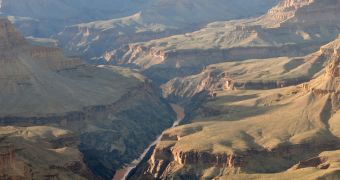A collaboration of researchers in the United Kingdom was recently able to discover a massive trough under Antarctica's ice sheets, which is estimated to have formed in ancient times, and to be significantly deeper than the Grand Canyon in the United States.
The work was carried out by experts with the British Antarctic Survey (BAS) and the universities of Newcastle, Bristol, Edinburgh, Exeter and York, all in England. At the time of the discovery, the team was analyzing the Ellsworth Subglacial Highlands in western Antarctica, PhysOrg reports.
These highlands are actually an ancient mountain range that has long since been buried under miles of ice. Since digging through such thick ices was unfeasible, the team decided to investigate the range by using satellite instrumentation and powerful radars attacked to skidoos and small aircraft.
After three seasons of collecting data at this location, the investigators were able to confirm the presence of a massive subglacial valley under the ice. The valley is estimated to be around 3 kilometers (1.86 miles) deep, which makes it even grander than the Grand Canyon.
The large trough spans a length of around 300 kilometers (186 miles), and is up to 25 kilometers (15.5 miles) across at some locations. From orbit, it looks like a very large and well-dug trench. Interestingly, the floor valley lies up to 2 kilometers (1.2 miles) under sea level in some places.
This landscape feature – which has been covered by ices for at least 30 million years – is believed to have been carved by mountain-top icefields similar to those that exist today in Alaska or the Arctic portions of Canada. The erosion process occurred long before the entire Southern Continent was covered by ice.
“While the idea of West Antarctic Ice Sheet growth and decay over the past few million years has been discussed for decades, the precise location where the ice sheet may originate from in growth phases, and decay back to in periods of decay, has not been known,” says University of Bristol professor of geosciences, Martin Siegert.
The trough “possesses classic glacial geomorphic landforms, such as u-shaped valleys and cirques, that could only have been formed by a small ice cap, similar to those seen at present in the Canadian and Russian High Arctic. The region uncovered is, therefore, the site of ice sheet genesis in West Antarctica,” the investigator concludes.

 14 DAY TRIAL //
14 DAY TRIAL //